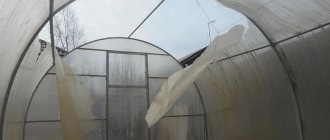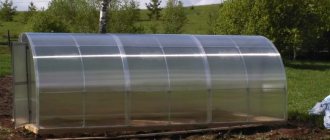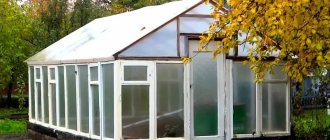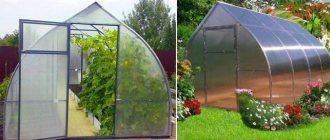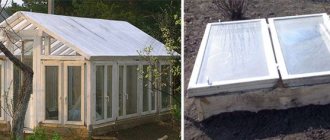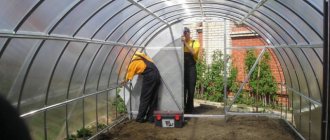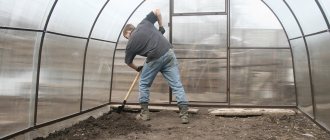After a long and harsh winter, the body requires increased intake of various vitamins. And it’s more natural to get them not from tablets, but from vegetables. And a simple greenhouse erected on a summer cottage will help to grow them early. Let's figure out how to assemble a polycarbonate greenhouse with your own hands and avoid common mistakes.
Coordinated actions when installing a greenhouse Source prom.st
Advantages of a polycarbonate greenhouse
It is well known that the type of material can influence the microclimate. Polycarbonate is better suited for a greenhouse than regular glass or film. After all, the material has qualities that distinguish it from others.
For example, the translucency of polycarbonate allows plants to fully receive their light requirement. But at the same time, the magnifying glass effect that glass structures suffer from is completely absent. And in the latter, the sun sometimes simply burns the young shoots.
Assembling a polycarbonate greenhouse is advantageous due to its structure. There are two types of material - monolithic and cellular. It is the latter that is recommended to be used for greenhouses. The honeycomb contains voids that are filled with air. This layer prevents the building from losing heat.
Also, each cell has stiffening ribs. Therefore, the design can be compared to a plastic window. But the material, for all its strength, is also quite flexible and elastic. This allows the construction of structures with a variety of geometric shapes. And also any types of roofs.
Assembling a polycarbonate greenhouse Source ytimg.com
Distinctive advantages of polycarbonate:
- Due to the low mass of the material, it is easy to transport, process and install.
- It has unique thermal insulation properties.
- Noise reduction reaches 25 decibels.
- It allows sunlight to pass through, but blocks ultraviolet radiation.
- Research has proven that polycarbonate sheets are 200 times stronger than glass.
- Not afraid of temperature changes.
- Can be used for at least 20 years.
- The material does not burn, and its melting begins only after the temperature rises above 550 °C.
- The sheathing has high resistance to any chemical aggression.
- Available for sale in a wide range of sizes.
If you assemble a greenhouse from polycarbonate, you can use it all year round. The material is not afraid of frost and snow. Able to easily withstand any gusts of wind. And in general, over the years of use it has shown itself only from the best side.
Polycarbonate
Attaching polycarbonate to the frame will not be difficult, since the material is really convenient to work with.
The most important thing is to use special self-tapping screws or screws equipped with a sealing gasket that will not allow moisture to get inside and harm the metal frame.
Common Build Errors
Polycarbonate structures also have disadvantages. But they can be attributed more to the human factor. For example, the wrong period of year for installing a greenhouse. After all, deformation of the material during installation is possible if the ambient temperature drops below 10 °C.
Fastening the end parts Source teplica2013.ru
See also: Catalog of companies that specialize in the design and installation of metal structures (canopies, greenhouses, etc.)
Choosing a permanent location for the greenhouse is important. In this case, there is no need to use temporary collapsible structures, which, unlike all-welded ones, lose strength. The latter are more reliable, have a maximum service life, and their installation is much faster and easier.
The above also has a direct bearing on lightweight structures. Their choice is completely unjustified. Meanwhile, structures with a reinforced frame do not even require additional maintenance.
The penetrating ability of sunlight is significantly affected by the angle of inclination of the polycarbonate sheet to the surface. In arched structures, part of the light is reflected from the surface and does not reach the plants. This is indicated by bright highlights on the rounded parts of the greenhouse. Therefore, assembling a polycarbonate greenhouse with flat surfaces is more preferable.
Laying sheets and fastening them Source scratchru.ru
But there are two main problems when working with polycarbonate. And the first is the use of low-quality material. After all, not all of its types are suitable for arranging greenhouses. In order not to complicate the checks, you can use the simplest of them. It is enough to weigh the polycarbonate sheet in the store. And if a shield with dimensions of 120 by 600 centimeters weighs less than 10 kg, then it must be discarded immediately.
The second biggest problem is the use of incorrect fasteners. To save money, some developers use ordinary self-tapping screws. And you only need to use polycarbonate thermal washers. And nothing else.
Where to place the greenhouse
Modern greenhouses can be disassembled and moved from one place to another, but this is a troublesome task, and it is not always possible to preserve the coating in its original form, since under the influence of natural conditions it gradually loses its properties.
Therefore, the choice of location for a house for plants must be approached thoroughly, and a number of rules must be taken into account:
- The distance between the main buildings and the greenhouse should be at least 2-3 m. A little shade and protection from the winds by the main buildings will benefit the structure, but strong shading is unacceptable.
- It is advisable to locate the greenhouse according to a geographical principle - from east to west. In this case, there will be the best illumination of the plants by the sun's rays and warming up of the entire building.
- Tall plants are not very good neighbors. In strong winds they can break and damage the lightweight coating. In addition, a powerful root system draws moisture and nutrients from the soil.
Step-by-step installation
First of all, it is necessary to carry out preparatory work. You need to choose an open area that will provide maximum sunlight and clear it for construction. The site should be 1.5 m larger in each direction than the size of the greenhouse.
According to the parameters of the greenhouse, a trench is dug to a depth of 25 cm, which is lined with waterproofing material. Its bottom is covered with a layer of sand 5 cm thick. Reinforcement is laid in the ditch and broken bricks and other large construction debris are filled. Then the trench is filled with cement mortar.
It is necessary to wait 2 weeks and only after this period begin subsequent work. If you buy a ready-made frame, then it must include detailed instructions from the manufacturer. It is necessary to familiarize yourself with it to identify possible nuances even before installation.
Trying on the sheet before fixing Source teplica-exp.ru
Let's look at how to assemble a polycarbonate greenhouse step by step:
- Along the perimeter of the foundation, a wooden beam is attached to the top using anchor bolts.
- Assembling the end of the greenhouse begins with installing the part in place and securing it to the beam.
- According to the drawings, a door is mounted on one side and a window on the other. All fittings are installed and their functionality is checked.
- Both ends are sewn up with polycarbonate sheets, from which the protective film is first removed. Excess material is cut off along the perimeter of the structure.
- The ends are temporarily secured with spacers.
- The frame arcs are installed on the side parts. They are fastened together with horizontal profiles. At this point, the assembly of the greenhouse frame is considered complete.
- The end parts are attached to the arcs and profiles.
- There are two ways to lay sheets on the frame. You can cut them to the desired size and mount them end-to-end, closing the seam using a profile and tapes. You can distribute the material overlapping.
Fastening polycarbonate sheets Source teplica-exp.ru
Types of foundations for a greenhouse
Modern greenhouses can be installed without a foundation; you just need to provide a connection to the ground using anchors or hooks. As a rule, they come complete with ready-made buildings and have different designs.
Most often this is a T-shaped or cross-shaped product at the end. Anchors are buried in the ground every 1-2 m, and firmly fastened to the base of the building with bolts. Thanks to this grip on the ground, the greenhouse will not fly away during periods of strong winds.
For a more stable position of the greenhouse, it is advisable to make a foundation. This issue is especially relevant if the site has a slope.
The most popular designs are:
- From timber. Easy to install, has excellent thermal insulation properties. Dimensions in diameter are 150x150 mm to 100x100 mm. The wood must be dry, treated with any means that protect against rotting;
- Columnar. The basis of such foundations are columns made of various materials. For light greenhouses, a reliable and fairly durable option. For large-sized models, the base is additionally strengthened;
- Tape. The simplest and cheapest type of foundation, which will ensure the strength and stability of the entire structure and protect the plants. The presence of a concrete mixer will simplify the work;
- Pile-grillage. It is used in areas with uneven ground and consists of a group of supports installed in the ground below the freezing mark. The strapping is made of rolled steel or reinforced concrete. The tape grillage is made of concrete, expanded clay blocks, brick, and stone.
Useful tips
Experts recommend:
- Buy polycarbonate sheets with a thickness of 6 to 8 mm. It is best to have UV protection.
- If you treat the lower part of the frame with bitumen solution, the service life can be significantly increased.
- Materials labeled “Eco” should be discarded. It has low strength due to the use of crushed recycled materials. It is better to give preference to a conventional primary polymer.
- To increase the stability of the greenhouse during strong gusts of wind, each arc of the frame is equipped with amplifiers.
Advantages and disadvantages
The popularity of the Osnova (reinforced) greenhouse is due to the following characteristics:
- resistance to the influence of external factors;
- simple installation;
- strength;
- versatility;
- reliability;
- reasonable cost;
- unpretentiousness.
Strength of the “Osnova” greenhouse
Disadvantages include difficulties with transportation. Their appearance is explained by their impressive size.
The manufacturer has achieved maximum strength through:
- small step between arcs;
- ends to which jumpers are welded;
- longitudinal ties.
There are special holes in the frame parts. Bolts and nuts for fixation are inserted into them. The stability of the structure largely depends on what the base of the greenhouse will be screwed to. The covering material is attached to the frame using galvanized tape, self-tapping screws and press washers. Installing a reinforced base will not take much time. Difficulties may arise when cutting polycarbonate sheets. The greenhouse is often equipped with a ventilation system.
Accessories
So, you have decided what the arches of the greenhouse frame will be made of, and you have also decided on the thickness of the polycarbonate slabs for the floor. Consider purchasing specialized fittings. This includes elements that securely hold the polycarbonate in place, preventing polymer ruptures and water from entering through them.
Polycarbonate sheets have a cellular structure and when cut transversely, open channel pores appear. Don't listen if they tell you that you can seal it with tape.
With repeated exposure to moisture and sun, the tape will peel off and microorganisms will enter the open channel. As a result, light transmission will decrease, and your greenhouse will shine with a “swamp green” color. Treatment is carried out with steam-permeable sealing tape.
A few words about the manufacturer
The Osnova greenhouse, which we are talking about today, is produced. And I would like to say a few words about this company, which has been operating for many years in Podolsk, St. Petersburg, and Vologda. At the moment, it is considered one of the best manufacturers of greenhouses, producing polycarbonate and frames made from square profiles with a section of 20*20, 25*25 and even 30*30 mm. The polycarbonate produced by the company is made from foreign raw materials from SABIC Innovative Plastics and can have a thickness from 4 to 16 mm.
Galvanized profile for greenhouse
The company is very sensitive to quality control and compliance with all production requirements, and therefore can boast of a high-quality and sought-after product.
On a note! The company has a narrow specialization, due to which it is focused only on the production of greenhouses and does not waste time on trifles. And the quality of the product only benefits from this.
is extremely responsible for quality control
The company is developing dynamically and already has a huge network of warehouses throughout Russia. That is why if you ordered a greenhouse on the website, it will arrive to you quite quickly. And most importantly, all the company’s products are designed taking into account the special climatic conditions of Russia. The “Osnova” greenhouse is one of those structures that are not afraid of absolutely anything.

